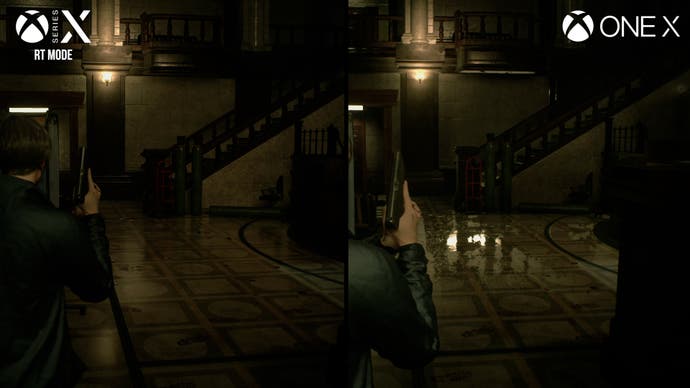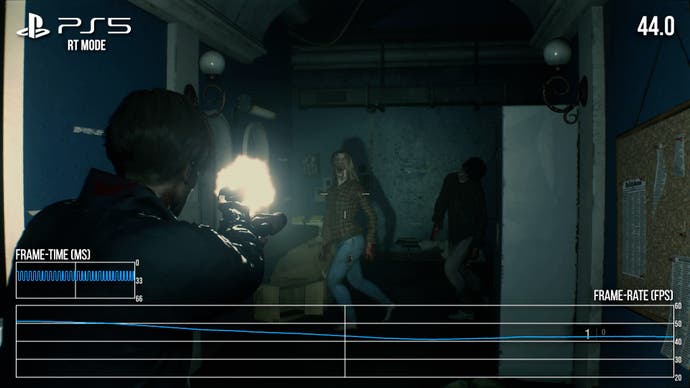Resident Evil 2/3 Remake: PlayStation 5 and Xbox Series upgrades tested
UPDATE: Resident Evil 7's patch added to the analysis.
UPDATE 23/6/22 6:10pm: We've now had the chance to complete the set, running the rule over the current generation console upgrades to Resident Evil 7 - the first game to use Capcom's excellent RE Engine. Perhaps inevitably, there's a great deal of commonality between RE7 and the remakes, with the same fundamental upgrades in place. There are high frame-rate and ray tracing toggles, offering three different performance modes: 60fps with or without RT in play, along with a 120Hz mode that only works with ray tracing disabled.
There are resolution upgrades, of course, and just like the Remakes, it's a case where PS5 and Xbox Series X run at 2160p using image reconstruction techniques to upscale from a lower resolution, while Series S targets a more conservative 1440p instead using the same upscaling algorithm. The good news is that the RT mode seems to deliver a locked 60fps on PS5 and Series X, but performance is still under par on Series S - though users of VRR displays will be fine (the alternative here is simply to disable RT, which locks you to 60fps). RT global illumination adds extra depth to the scene, but as you'll see in the video below, RT reflections are a mixed bag.
The 120Hz high frame-rate mode is great across the board, however. The same 2160p/1440p targets remain in place and all consoles do a great job of delivering the requisite high performance. Indeed, PS5 and Series X are essentially locked to the target, and while Series S can still drop to circa 100fps, it's still exceptional on a VRR display and not too bad on a conventional display either. Ultimately, while the ray tracing could have been better, RE7's patch delivers - and it's a great excuse to revisit a classic survival horror title.
ORIGINAL STORY: In the wake its 'E3' press conference last week, Capcom left us with a rather thoughtful gift: current-gen upgrades for Resident Evil 2 Remake, Resident Evil 3 Remake and Resident Evil 7. In common with prior RE engine titles running on PlayStation 5 and Xbox Series consoles, the new features include higher resolution, ray tracing and 120Hz support. Stacked up against PS4 and Xbox One versions - and their enhanced equivalents - we're looking at a substantial suite of upgrades, but for the remake titles at least, the new versions aren't without their minus points.
Owing to the sheer volume of test cases here, we've opted to split up the coverage. After all, even factoring out the PC upgrades (which we're also covering a little further on down the road), we're still talking about three games with three different performance profiles - 27 different test permutations. With that in mind, we've opted to target the Remakes first.
Of all the various modes on offer, it's the ray tracing upgrade we wanted to take a look at first because in theory, it should eliminate one of the most glaring visual issues with the Remake titles - an ugly rendition of screen-space reflections wholly at odds with what is otherwise a high quality presentation across the board. The issue with SSR is very straightforward: by their very nature, screen-space reflections can only work where there is screen-space detail to work with. In a third-person action game like Resident Evil, the main character on-screen occludes a lot of the required detail, leading to some massive gaps in the reflections. This is compounded by low-quality reflections when the data is actually there.
In common with prior RE titles, there are actually two RT effects in play: reflections and global illumination. The reflections offer the most visually obvious improvements: all of the occluded omissions are gone, while the low-quality reflections and their associated 'fizzle' are also a thing of the past. To be clear, just like Resident Evil Village, the reflections are still fairly low resolution, but it's a big improvement regardless. The clarity of the effect depends on the roughness of the underlying material, with smooth surfaces seeing the cleanest results. Enemies are reflected as well, though alpha effects understandably don't make the cut. In general, the new RT reflections look subtle but stable, though the selective application of RT reflections is disappointing - for example, some mirrors don't offer proper reflections. However, from what I've played, Resident Evil 3 Remake seems to improve the distribution of RT reflections compared to its predecessor.
Ray traced global illumination is also in effect, though the results are generally on the subtle side. Some of the smaller inaccuracies present in the original release are fixed, while some extra bounce lighting is visible in some scenes. This is definitely an additive technique, rather than a replacement for the existing baked GI, but the results are reasonable considering the limitations. The RT GI also seems to disable the ambient occlusion, with somewhat mixed results. All told, both RT features fail to provide a transformative improvement to the Remakes' visuals, but they do manage to address their most obvious visual flaws while touching up some discontinuities in ambient lighting.
PlayStation 5 and both Xbox Series consoles receive the RT upgrades, with the more powerful machines targeting what presents like a checkerboarded 2160p, while Series S aims for a similarly reconstructed 1440p - the lower resolution on the junior Xbox also resulting in correspondingly lower resolution RT reflections. Still, all the machines look suitably clean and clear, though the image is a bit soft owing to a heavy reliance on post-processing. Relative to the existing Xbox One X version, which ran at 1620p with reconstruction, image quality is indeed improved, though the differences are often subtle despite a fairly large increase in resolution on the new Series X code. Fine detail like hair is improved and distant textures resolve somewhat more clearly, but in typical play it doesn't seem far off.


Performance is a mixed bag depending on the mode chosen. Perhaps not surprisingly, the RT mode is the heaviest on the hardware. The more powerful machines operate mostly in 40-60fps territory - a bit of a frame-rate no-man's land. Constant judder and inconsistent input are the result on a conventional display. Series S suffers somewhat more and generally operates around 30-50fps, with a low of 26fps during one particularly demanding cutscene. VRR makes a difference, but only really for Xbox Series X where the performance level stays above the required 40fps level (assuming your display supports 40Hz VRR). The other machines 'ping pong' in and out of the the VRR window, which isn't a great experience.
So, on the one hand, I like the RT support and how it cleans up the visuals - but the amount of users who can effectively use that mode in a smooth, pleasing way amounts to a minority of the audience. The performance drop is disappointing, to be honest. A similar RT implementation surfaced in last year's Resident Evil Village, after all, and that title mostly stuck to 60fps on PS5 and Series X. Image quality isn't far off the PS4 Pro or Xbox One X versions, but performance is certainly more consistent.
That leaves us with the high frame-rate mode from the game's options, which again delivers the same reconstructed 4K/1440p resolution with no RT, but removes the frame-rate cap, opening the door to performance up to 120Hz for those with displays that supported the increased refresh rate. There are no other settings adjustments, meaning that PS5 and Series X both tend to stick between 80-120fps, though they usually hang around 100fps or so. Series S is similar, though it tends to bottom out a touch lower, with some readings in the 70fps area in intense moments. Between Series X and PS5, the frame-rates are fairly similar, though the Series X tends to have a small performance advantage in matching footage - around 5fps - though it varies somewhat.
The improved image response and fluidity is certainly appreciated, but again this is a mode best suited for use on VRR displays. As frame-rates increase, frame-time inconsistencies become less prominent and the perception of judder decreases, but I still found the unlocked framerate distracting on a non-VRR TV. VRR saves the day of course and will give you a smooth and stable-feeling output on a suitable screen. I do like the option to play at 120Hz, but a more stable lock to 120fps would have been appreciated - we're unlikely to be CPU-limited given the performance of these titles on the last-gen enhanced machines, so some graphical settings tweaks might have been enough to produce a stable 120fps.

We'll be looking at Resident Evil 7 separately soon and will update this article accordingly, but in the here and now, the upgrades to the Resident Evil 2 and 3 Remakes are welcome, but not quite ideal. There are decent improvements here, with solid upgrades to graphical fidelity and performance available across all three consoles - even the Xbox Series S. The problem is that frame-rates are just too inconsistent across two out of the three available modes, with both the ray tracing and high frame-rate modes typically failing to reach their frame-rate targets. Most users should really stick to the non-RT, non-high frame-rate profile here, as it is the only way to achieve stable performance.
If you are part of the minority of users who has a display that is capable of VRR and 120Hz, you have more options. The 120Hz mode offers a sizeable upgrade in fluidity over the 60hz non-RT mode as long as VRR is enabled. Likewise, VRR helps salvage the RT modes to some degree, though only the Series X paired with a 40-60Hz VRR window feels stable enough to be worth recommending.
But VRR should be a bonus, not a necessity. With some tweaks, more stable frame-rates should be possible in these modes. Cutting resolution may be a good place to start, as the games' dark and low-contrast colour scheme plus their heavy reliance on post-processing minimises the need to push a lot of pixels. As it stands, though, the RT and high frame rate modes really demand a variable refresh to look smooth. And that's a shame, because I think these modes present some compelling features. The RT modes have particular appeal, as they manage to overcome one of the most obvious visual flaws with the original releases, while improving the complexity and consistency of ambient shading as well. Resident Evil 3 particularly benefits, with its high density of reflective surfaces. Perhaps these performance problems can be fixed in time. Until then, this is an intriguing upgrade - but you'll need an advanced display to make the most of it.



